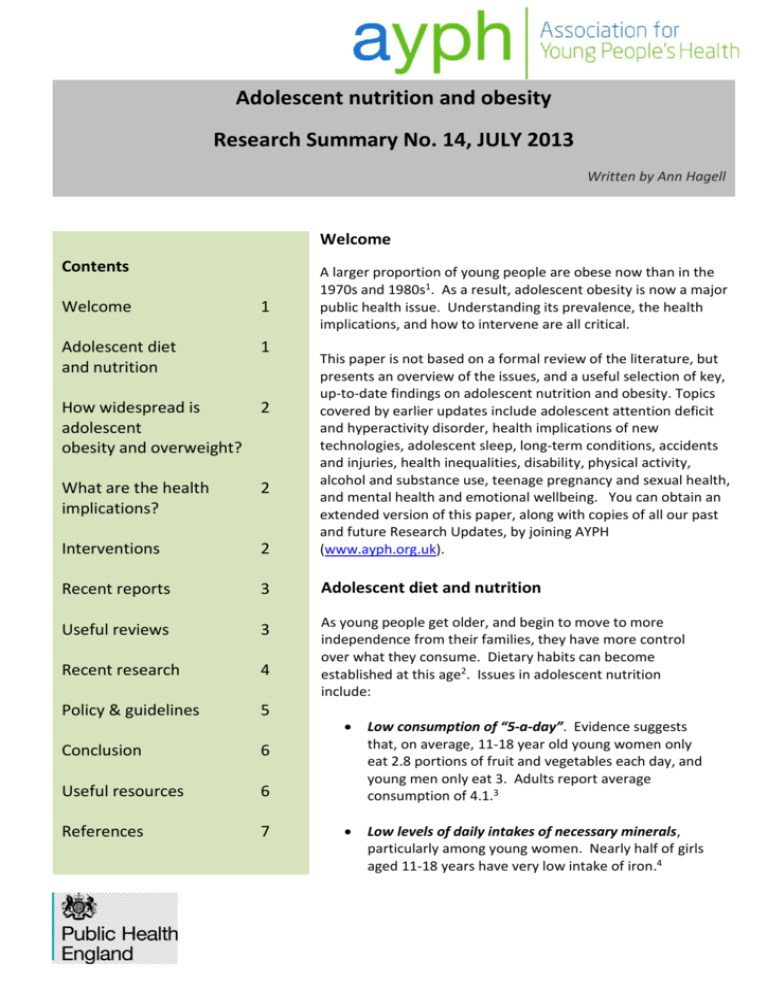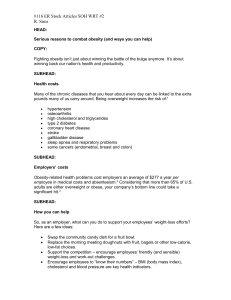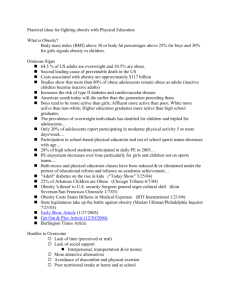Adolescent nutrition and obesity Research Summary No. 14, JULY
advertisement

Adolescent nutrition and obesity Research Summary No. 14, JULY 2013 Written by Ann Hagell Welcome Contents A larger proportion of young people are obese now than in the 1970s and 1980s1. As a result, adolescent obesity is now a major public health issue. Understanding its prevalence, the health implications, and how to intervene are all critical. Welcome 1 Adolescent diet and nutrition 1 How widespread is adolescent obesity and overweight? 2 What are the health implications? 2 Interventions 2 This paper is not based on a formal review of the literature, but presents an overview of the issues, and a useful selection of key, up-to-date findings on adolescent nutrition and obesity. Topics covered by earlier updates include adolescent attention deficit and hyperactivity disorder, health implications of new technologies, adolescent sleep, long-term conditions, accidents and injuries, health inequalities, disability, physical activity, alcohol and substance use, teenage pregnancy and sexual health, and mental health and emotional wellbeing. You can obtain an extended version of this paper, along with copies of all our past and future Research Updates, by joining AYPH (www.ayph.org.uk). Recent reports 3 Adolescent diet and nutrition Useful reviews 3 Recent research 4 As young people get older, and begin to move to more independence from their families, they have more control over what they consume. Dietary habits can become established at this age2. Issues in adolescent nutrition include: Policy & guidelines 5 Conclusion 6 Useful resources 6 References 7 Low consumption of “5-a-day”. Evidence suggests that, on average, 11-18 year old young women only eat 2.8 portions of fruit and vegetables each day, and young men only eat 3. Adults report average consumption of 4.1.3 Low levels of daily intakes of necessary minerals, particularly among young women. Nearly half of girls aged 11-18 years have very low intake of iron.4 2 Irregular eating. Although a very small proportion report never eating regularly (3%)5, more independence and more flexible timetables at this age could mean less structured eating patterns for many more. Over reliance on fast food. As many as 17% of British secondary school children report daily consumption of food high in fat, salt or sugar and low in nutritional value.5 How widespread is adolescent obesity and overweight? Measuring obesity usually involves measurement of weight in relation to height (Body Mass Index)6. If the BMI of a young person falls on or above the 85th centile of the British 1990 growth reference they are considered overweight. If their BMI falls on or above the 95th centile they are considered obese.7 In 2011, a fifth of children aged 11-15 were classified as obese according to data from the Health Survey for England. The National Child Measurement Programme data for 2011/12 showed that a fifth (19.2%) of pupils aged 10-11 were obese, and a further 14.7% were overweight.8 Altogether a third of young people were obese or overweight by the final year of primary school.9 Different data, from the Health Survey for England, show an increase in obesity for 11-15 year old boys from 13.9% in 1995 to 24.3% in 2004, but by 2011 this had fallen slightly to 23.8%.10 Among 11-15 year old girls, obesity increased from 15.5% in 1995 to 26.7% in 2004, but decreased to 16.5% by 2011.8 There are links between adolescent obesity and socioeconomic deprivation. The National Child Measurement Programme has demonstrated that young people in Year 6 living in disadvantaged urban communities and in multicultural city centres have higher rates of obesity than the England average. 11 What are the health implications? Obese and overweight adolescents may suffer from a range of health problems including musculoskeletal difficulties, breathing problems, asthma, obstructive sleep apnoea, prediabetes (disturbed blood glucose levels), poorer mental health, stigmatisation and low self-esteem.12 13 14 Obese adolescents are more likely to become obese adults and have higher risk of morbidity, disability and premature mortality in adulthood,15 including development of Type 2 diabetes and cardiovascular problems.16 Interventions NICE guidelines recommend public health interventions including schemes to improve facilities for cycling and walking and improvements to the school environment including the content of vending machines. Multicomponent interventions that aim to increase activity at the same time as improving eating behaviour and diet are best. Bariatric surgery is not recommended for children.17 18 Interventions such as food labelling may play a modest role, but are subject to a struggle between the food industry and public health bodies for regulatory influence.19 Other issues include the public health ‘Responsibility Deal’,20 national opportunities for minimum pricing and local responsibility for planning of fast food outlets and provision of green spaces and leisure areas. 3 Recent reports Academy of Medical Royal Colleges (2013) Measuring up: The medical profession’s prescription for the nation’s obesity crisis. Report of the Academy’s inquiry into obesity. Suggests ten ideas, falling under three headings; actions to be taken by healthcare professionals, changes to the obesogenic environment, and making healthy choices easier. http://www.aomrc.org.uk/projects/obesity-steering-group.html National Child Measurement Programme: Ridler, Dinsdale and Rutter (2013) Changes in children’s body mass index between 2006/7 and 2011/12. http://www.noo.org.uk/uploads/doc/vid_17929_NCMP_Changes_children.pdf The NCMP measures children in Reception (age 4-5) and Year 6 (age 10-11) on an annual basis. The findings from the 2011/12 report were particularly striking for the Year 6 group where there had been a significant upwards trend in the prevalence of obesity for both girls and boys since 2006/7. Overall, 19.2% of Year 6 children were obese, compared with 9.5% of Reception aged children. The report shows that BMI is increasing across the whole population, and there is also evidence that socioeconomic inequalities appear to be widening. National Diet and Nutrition Survey, Bates et al (2012), NDNS Headline Results from Years 1, 2 and 3 (combined) of the Rolling Programme (2008/9 – 2010/11). http://www.natcen.ac.uk/media/978078/ndns-y3-report_all-text-docs-combined.pdf The National Diet and Nutrition Survey (NDNS) is a programme of surveys designed to assess the diet, nutrient intake and nutritional status of the general population aged 18 months and over living in private households in the UK. The NDNS is jointly funded by the Department of Health in England and the UK Food Standards Agency. The NDNS involves an interview, a four-day dietary diary and blood and urine samples. There are useful data on adolescent nutrition and nutritional deficiency, particularly drawing attention to the shortfalls in the diet of many young women. Useful recent reviews The health indicators associated with screen-based sedentary behaviour among adolescent girls: a systematic review Costigan S, Barnett L, Plotnikoff R and Lubans D (2013) Journal of Adolescent Health, 52, 382-392 http://www.ncbi.nlm.nih.gov/pubmed/23299000 Adolescent girls are particularly prone to reducing their activity levels as they get older, and much of their sedentary time is spent on screen-based behaviours. There was evidence for a strong relationship between screen-based sedentary behaviour and weight, and also with sleep problems, musculoskeletal pain and depression. Eating frequency and overweight and obesity in children and adolescents: A meta-analysis. Kaisari P, Yannakoulia M and Panagiotakos D (2012) Pediatrics, 131 958-967 http://pediatrics.aappublications.org/content/early/2013/04/03/peds.2012-3241.abstract Eleven studies with a total of 18,849 participants (aged 2-19) were combined in the meta-analysis, revealing that eating frequently was associated with lower weight, although the relationship was strongest for boys and did not reach significance for the girls. As the authors point out, the biological mechanisms are not clear so we do not yet know why this might be the case. 4 TV viewing and obesity in children and young people. National Obesity Observatory (2012) http://www.noo.org.uk/uploads/doc/vid_15867_TV_viewing.pdf This succinct review summarises the latest information from 31 studies on the topic, concluding that TV viewing is associated with weight problems. Distinctions are not made between the behaviour of children and adolescents - it would be useful to know whether the patterns vary with age - but the review provides a useful starting point on a topic of concern to many people. Recent research Consumers’ estimation of calorie content at fast food restaurants: cross sectional observational study. Block J, Condon S, Kleinman K et al (2013) British Medical Journal [epub ahead of print] http://www.bmj.com/content/346/bmj.f2907 Surveys were administered to customers outside the entrance to fast food restaurants, including adults over 18, adolescents aged 11-20, and school children aged 3-15. Participants were asked to estimate their meal’s calorie content, and to estimate their average daily calorie requirement. All ages underestimated how many calories there were, and interestingly the adolescents underestimated the most. More information about calorific content was recommended. Cross-sectional survey of daily junk food consumption, irregular eating, mental and physical health and parenting style of British secondary school children. Zahra J, Ford T and Jodrell D (2013) Child Care Health Dev. [epub ahead of print] http://www.ncbi.nlm.nih.gov/pubmed/23594136 Over 10,000 young people aged 12-16 reported on their consumption of junk food, irregular eating, physical and mental health, and perceived parenting. Eating junk food on a daily basis was reported by 17.2%, and 2.9% of the sample reported never eating regularly at all. Poor eating behaviour was related to various poor health outcomes, and having authoritative parents was related to better eating behaviour and good health outcomes. Family meals among New Zealand young people: Relationships with eating disorders and Body Mass Index. Utter J, Denny S, Robinson E,Fleming T, Ameratunga S and Grant S (2013) Journal of Nutrition Education and Behaviour. 45, 3-11 http://www.jneb.org/article/S1499-4046(12)00396-X/abstract Based on a large survey of randomly selected adolescents aged 13-17 years, this study showed that over half of the young people had family meals five or more times a week. Family meals were associated with healthier eating (fruit and vegetables), but in this survey there was no relationship between having family meals and BMI. The role of family meals may be more about consumption of healthy food than a weight reduction strategy. Is obesity at individual and national level associated with lower age at menarche? Evidence from 34 countries in the Health Behaviour in School-Aged Children study Currie C, Ahluwalia N, Godeau E, Gabhainn S, Due P and Currie D (2012) Journal of Adolescent Health, 50, 621-626. http://www.jahonline.org/article/S1054-139X(11)00609-4/fulltext Data from nearly 28,000 15 year olds in 34 countries in 2005/6 showed substantial variation among individuals and across countries in age at menarche. Menarche ranged from 12 years & 5 months in Italy to 13 years and 5 months in Latvia. Prevalence of overweight also varied by country, and there was a significant negative association between individual BMI and age at menarche. For each unit increase in BMI, age at menarche was earlier by about 1 month. 5 Associations between obesity and comorbid mental health, developmental and physical conditions in a nationally representative sample of US children aged 10 to 17 Halfon N, Larson K and Slusser W (2013) Academic Pediatrics, 13, Vol 1, 6-13 http://www.ncbi.nlm.nih.gov/pubmed/23200634 Cross sectional data on 43,000 children aged 10-17 involved in the 2007 National Survey of Children’s Health revealed that obese children have increased odds of worse general health. The 16% who were obese (BMI>=95th percentile) were more likely to report attention deficit/hyperactivity disorder, conduct disorder, depression, learning disability, developmental delay, musculoskeletal problems, asthma, allergies, headaches and ear infections. Sleep duration and adolescent obesity Mitchell J, Rodriguez D, Schmitz K and Audrain-McGovern J (2013) Pediatrics, 131, 1428-1434 http://pediatrics.aappublications.org/content/early/2013/04/03/peds.2012-2368.abstract A large sample of 1,390 adolescents was followed up from age 14 to 18. BMI increased across this period, and every additional hour of sleep was associated with decreases in BMI. The relationship was strongest for those with higher BMIs. The authors suggest that increasing sleep could lead to a reduction in BMI and help prevent overweight and obesity. Exploring the complex pathways among specific types of technology, self-reported sleep duration and body mass index in UK adolescents Arora T, Hussain S, Lam K, Yao G, Thomas G, Taheri S (2013) International Journal of Obesity, (Epub ahead of print) http://eprints.soton.ac.uk/352885/ Taking both sleep and use of technology as important variables, the authors demonstrated that use of four different kinds of technology was associated with reduced sleep, and also (with the exception of mobile phone use) with increased BMI . The sample consisted of 632 girls aged 11-18 years taking part in a school based study. Their suggestion is that reduced sleep duration is the link between overuse of technology and increased BMI. Parenting an overweight or obese teen: Issues and advice from parents Boutelle K, Feldman S, Neumark-Sztainer D (2012) Journal of Nutrition Education and Behaviour 44, 500506. http://www.ncbi.nlm.nih.gov/pubmed/22770833 This interesting qualitative study draws on interviews with 27 parents of adolescents who were overweight, or who had been overweight. Alongside their concern for their child’s well-being, parents were worried about how to communicate effectively, felt thwarted by their inability to control their young person’s decisions and behaviour, and struggled with feelings of guilt and responsibility. They recommended strategies for improving young people’s autonomy and reducing negative emotions. Policy and guidelines Recent policy documents include the following although very few are specific to adolescents. Children and Young People’s Health Outcomes Forum recommended an obesity indicator for age 16-17 years and the establishment of a Local Health and Wellbeing Survey for Young People in local authority areas. Action on obesity: Comprehensive care for all. Report of a Working Party (2013) Royal College of Physicians 6 Behaviour change, public health and the role of the state – BMA position statement (2012) Tackling obesity: local government’s new public health role. Local Government Association (2012). Healthy Lives, Healthy People: A call to action on obesity in England. Department of Health, October 2011 https://www.gov.uk/government/publications/healthy-lives-healthy-people-a-call-toaction-on-obesity-in-england Aims to encourage a downward trend in the level of excess weight in children by 2020. Start Active, Stay Active: A report on physical activity for health from the four home countries’ Chief Medical Officers (2011), and related factsheets including Physical activity guidelines for children and young people 5-18 years https://www.gov.uk/government/uploads/system/uploads/attachment_data/file/213739/dh_128144.pdf Conclusion Obesity in adolescents has clearly increased since the 1970s and 1980s. A quarter of secondary school children are obese. Understanding adolescent nutrition is important, and more research on this would be useful. Apart from the prevalence data, much of the available material about obesity is not specific to the adolescent age group but either covers the whole age range or children and adolescents together. Health behaviour and responses to intervention are likely to be different in adolescents. Understanding how to intervene effectively requires more understanding of their particular needs. Examples of useful resources (extended list in our full research update) British Diabetic Association, Teen Weight Wise website . http://www.teenweightwise.com/index.html Child and Maternal Health Intelligence Network, now part of Public Health England, provides a wide range of resources on health and wellbeing including a dedicated focus on obesity: http://www.chimat.org.uk/obesity National Obesity Forum, which includes pages for practitioners with, for example, resources for managing obesity in primary care. http://www.nationalobesityforum.org.uk/ Obesity Knowledge and Intelligence (formerly National Obesity Observatory) now part of Public Health England, provides a wide range of resources for practitioners including data factsheets and briefing papers. There is also a regular obesity e-bulletin to sign up for. http://www.noo.org.uk/ Youth Health Talk module on health and weight http://www.youthhealthtalk.org/young_people_health_and_weight/ResourcesAndInformationArticles/4656 7 REFERENCES 1 Butland B, Jebb S, Kopelman P et al (2007) Foresight Tackling Obesities: Future choices – project report. London: Government Office for Science, Department of Innovations, Universities and Skills. 2 Sweeting H, Anderson A, West P (1994) Socio-demographic correlates of dietary habits in mid to late adolescence.Eur J Clin Nutr 48 :736– 748, 3 Bates B, Lennox A, Prentice A, Bates C and Swan G (2012) National Diet and Nutrition Survey: Headline results from Years 1,2 and 3 (combined) of the Rolling Programme 2008/9-2010/11. Department of Health 4 Bates et al (2012) op cit 5 Zahra J, Ford T, Jodrell D (2013) Cross-sectional survey of daily food consumption, irregular eating, mental and physical health and parenting style of British secondary school children. Child Care Health Dev (Epub ahead of print). 6 Dinsdale H, Ridler C and Ellis L (2011) A simple guide to classifying body mass index in children. Oxford: National Obesity Observatory 7 Health and Social Care Information Centre (2013) Statistics on obesity, physical activity and diet: England, 2013. Leeds: The Health and Social Care Information Centre 8 HSCIC (2013) op cit 9 Ridler C, Dinsdale H, Rutter H (2013) National Child Measurement Programme: Changes in children’s body mass index between 2006/7 and 2011/12. Oxford: National Obesity Observatory 10 HSCIC (2013) op cit 11 Ridler C, Dinsdale H, Rutter H.(2011) National Child Measurement Programme: Analysis using ONS Area Classification. Oxford:National Obesity Observatory 12 Centers for Disease Control and Prevention (2013) Childhood Obesity Facts. http://www.cdc.gov/healthyyouth/obesity/facts.htm 13 Gatineau M, Dent M (2011) Obesity and mental health. Oxford: National Obesity Observatory 14 Public Health England (2013), Health risks of childhood obesity. Web page downloaded from http://www.noo.org.uk/NOO_about_obesity/obesity_and_health/health_risk_child 15 Reilly J, Kelly J (2011) Long-term impact of overweight and obesity in childhood and adolescence on morbidity and premature mortality in adulthood: systematic review. International Journal of Obesity, 35, 891-8 16 Friedemann C, Heneghan C, Mahtani K, Thompson M, Perera R and Ward A (2012) Cardiovascular disease risk in healthy children and its association with body mass index: systematic review and meta-analysis. British Medical Journal, 345. 17 NICE (2006) Obesity: guidance on the prevention, identification, assessment and management of overweight and obesity in adults and children. National Institute for Health and Clinical Excellence. 18 Oude Luttikhuis H, Baur L, Jansen H, Shrewsbury V , O’Malley C, Stolk R and Summerbell C (2009) Interventions for treating obesity in children. Cochrane Database of Systematic Reviews, Issue 1, Art. No. CD001872 19 Magnusson R (2010) Obesity prevention and personal responsibility: the case of front of pack food labelling in Australia. BMC Public Health, 10, 662 20 https://responsibilitydeal.dh.gov.uk/ For more information, visit www.ayph.org.uk and follow us on Twitter @AYPHCharity This Research Update has been produced with the support of the Child and Maternal Health Intelligence Network, Public Health England (www.chimat.org.uk) The opinions and views expressed in this Research Update are the opinions of the designated authors and do not reflect the opinions or views of any part of PHE or any other individual or organisation






